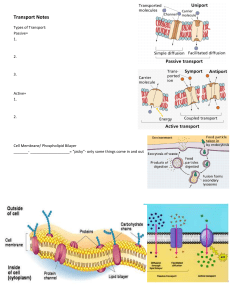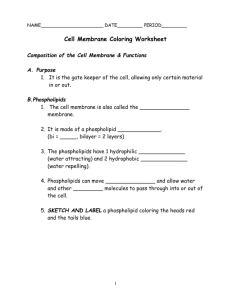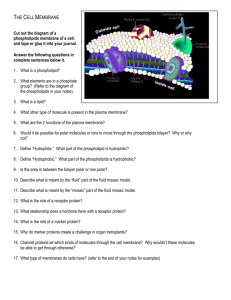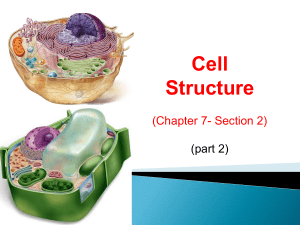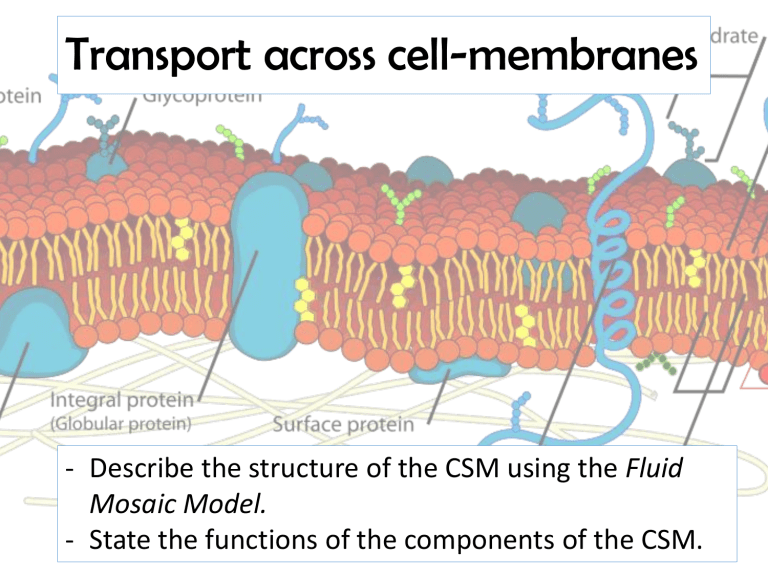
Transport across cell-membranes - Describe the structure of the CSM using the Fluid Mosaic Model. - State the functions of the components of the CSM. The Cell Surface / Plasma Membrane • All membranes around and within cells (e.g. organelles) have the same basic structure: plasma membranes. • Cell surface membrane = membrane which surrounds cells. Forms a barrier between cell cytoplasm, and its environment allows different conditions to be established inside and outside of the cell. • It is selectively permeable allowing some substances to pass through, whilst blocking others. PLASMA MEMBRANE The Cell Membrane appears under the electron microscope as a double line. The width of the cell membrane does not vary between organisms it is 7-8 nm. What are membranes? Membranes cover the surface of every cell, and also surround most organelles within cells. They have a number of functions, such as: keeping all cellular components inside the cell allowing selected molecules to move in and out of the cell isolating organelles from the rest of the cytoplasm, allowing cellular processes to occur separately. a site for biochemical reactions allowing a cell to change shape. 4 of 10 © Boardworks Ltd 2009 STRUCTURE OF THE CELL MEMBRANE The cell membrane is made up of almost entirely phospholipids and proteins. Phospholipids – form bilayers – one sheet of phospholipid forming over another. Made up of: Polar head (HYDROPHILIC) attracted to other polar molecules such as water. Fatty Acid Tails- non-polar (HYDROPHOBIC) and repel water 5 of 10 © Boardworks Ltd 2009 What is a phospholipid? phosphate group phosphoester bond Polar hydrophilic Head. Faces the watery environment glycerol ester bond fatty acid It’s a pair of fatty acid chains and a phosphate group attached to a glycerol backbone. Non polar hydrophobic Tail faces away from water PHOSPHOLIPID BILAYER PHOSPHOLIPID BILAYER forms the basis of membrane structure. The phospholipid component allows lipid-soluble (non-polar) molecules to enter and leave the cell, but prevents water soluble (polar) molecules from doing so. 8000 stacked membranes thickness of a piece of paper Phospholipid Bilayer Lipid bilayer – two sheets of lipids (phospholipids). Found around the cell, nucleus, vacuoles, mitochondria, Chloroplasts lysosomes Embedded with extrinsic and intrinsic proteins and strengthened with cholesterol molecules. The polar hydrophilic heads are water soluble and the hydrophobic tails are water insoluble Hydrophobic (water-hating) tail air aqueous solution Hydrophilic (water-loving) head Phospholipids form micelles when submerged in water The CSM is formed from a phospholipid bilayer Extracellular space (aqueous) Phosphate heads face aqueous solution phospholipid bilayer Cytoplasm (aqueous) Hydrophobic tails face inwards Davson-Danielli Model • A model of the plasma membrane of a cell, proposed in 1935 by Hugh Davson and James Danielli. • The model describes a phospholipid bilayer that lies between two layers of globular proteins. Protein Phospholipid bilayer Model was replaced by the more correct model proposed in 1972 Davson-Danielli Model Reasons for the model: 1. Chemical analysis of membranes showed that they were composed of phospholipid and protein. 2. Evidence suggested that the plasma membrane of red blood cells has enough phospholipids in it to form an area twice as large as the area of the plasma membrane – suggesting a phospholipid bilayer. 3. Experiments showed that membranes form a barrier to passage of some substances, despite being very thin, and layers of protein could act as the barrier. Appearance of the Cell Membrane Seen using a light microscope, the cell membrane appears as a thin line, but with an electron microscope, it appears as a double line. } 7 – 8 nm 4.6 Davson-Danielli Model Testing the model Electron microscopes first produced in 1950s. Images reveled membranes to appear as two dark lines separated by a lighter band – seemed to fit the Davson- Danielli model as proteins usually appear darker than phospholipids. The Fluid Mosaic Model • Electron microscope furthered understanding of membrane structure. • In the 1970s, Singer and Nicholson used techniques such a freeze-etching. • Showed that proteins were distributed throughout the lipid in a mosaic pattern. • Found that the membrane was fluid and phospholipids could move relative to each other. • Proposed the Fluid Mosaic Model – still favoured. The fluid mosaic model of the plasma membrane The proteins can move freely through the lipid bilayer – FLUID. The ease with which they do this is dependent on the number of phospholipids with unsaturated fatty acids in the phospholipids. The proteins form a MOSAIC pattern within the phospholipid bilayer Fluid Mosaic Model of the Plasma Membrane Carbohydrate chain Glycoprotein Intrinsic Protein Non-polar hydrophobic fatty acid Phospholipids • Fluid: CSM has a flexible structure and constantly changes shape. Because individual phospholipid molecules can move relative to one another. • Mosaic: proteins embedded within the bilayer are different in shape and size – similar to the tiles of a mosaic. Biochemical Composition of the Plasma Membrane Side view Surface view Biochemical Composition of the Plasma Membrane The main components are protein and phospholipid: Protein Phospholipid Side view 4.6 Surface view This model is referred to as the ‘fluid mosaic model’ because the components are free to move independently of each other. 4.6 Phospholipid Hydrophilic head - water loving Hydrophobic tail - water hating 4.6 Fatty acid tail Phospholipid bilayer Phosphate head The role of phospholipids in membranes is to act as a barrier to most substances, helping control what enters/exits the cell. Generally, the smaller and less polar a molecule, the easier and faster it will diffuse across a cell membrane. Function of phospholipids in the membrane: - Allow lipid-soluble substances to enter and leave. - Prevent water-soluble substances entering and leaving. - Make the membrane both flexible and selfsealing. Fatty acid tail Phospholipid bilayer Phosphate head Cholesterol Cholesterol in cell membranes Cholesterol is a type of lipid with the molecular formula C27H46O. Cholesterol is very important in controlling membrane fluidity. The more cholesterol, the less fluid – and the less permeable – the membrane. Cholesterol is also important in keeping membranes stable at normal body temperature – without it, cells would burst open. 27 of 13 © Boardworks Ltd 2009 Cholesterol in cell membranes Very hydrophobic, therefore plays an important role in preventing loss of water and dissolved ions from cell. Cholesterol fits in between phospholipids molecules to increase rigidity and stability by reducing lateral movement of other molecules. 28 of 13 © Boardworks Ltd 2009 Intrinsic protein Carbohydrate branch Glycoprotein Fatty acid tail Phospholipid bilayer Extrinsic protein Phosphate head Cholesterol Proteins in membranes Proteins typically make up 45% by mass of a cell membrane, but this can vary from 25% to 75% depending on the cell type. Function of proteins: - Provide structural support carbohydrate chain integral protein - Act as channels to transport water-soluble substances - Allow active transport through carrier proteins - Form cell-surface receptors - Helps cell adhere together peripheral protein - Act as receptors, e.g. for hormones 30 of 13 © Boardworks Ltd 2009 Proteins in membranes Integral (or intrinsic, or transmembrane) proteins span the whole width of the membrane. carbohydrate chain integral protein Peripheral (or extrinsic) proteins are confined to the inner or outer surface of the membrane. peripheral protein Many proteins are glycoproteins – proteins with attached carbohydrate chains. 31 of 13 © Boardworks Ltd 2009 Intrinsic proteins Many intrinsic proteins are carrier molecules or channels. These help transport substances, such as ions, sugars and amino acids, that cannot diffuse across the membrane but are still vital to a cell’s functioning. Other integral proteins are receptors for hormones and neurotransmitters, or enzymes for catalyzing reactions. 32 of 13 © Boardworks Ltd 2009 Extrinsic proteins Extrinsic proteins may be free on the membrane surface or bound to an integral protein. Extrinsic proteins on the extracellular side of the membrane act as receptors for hormones or neurotransmitters, or are involved in cell recognition. Many are glycoproteins (protein attached to polysaccharide) . Extrinsic proteins on the cytosolic side of the membrane are involved in cell signalling or chemical reactions. They can dissociate from the membrane and move into the cytoplasm. 33 of 13 © Boardworks Ltd 2009 MEMBRANE PROTEINS Type of protein Where on membrane Extrinsic proteins Intrinsic protein Function Appears on the surface or Supports the membrane. partially implanted into the Acts as a receptor site membrane and recognition site for identification Extending along the two polar layers Carriers to transport large molecules such as glucose or for active transport. Channels for water soluble materials 34 of 13 © Boardworks Ltd 2009 Glycoproteins Glycoproteins • A protein joined to a polysaccharide • Some for recognition • Some are antigens • Some proteins are involved in active transport • They transport molecules or ions against a concentration gradient. Intrinsic protein Carbohydrate branch Glycolipid Glycoprotein Fatty acid tail Phospholipid bilayer Extrinsic protein Phosphate head Cholesterol Glycolipids • Carbohydrate (polysaccharide) covalently bonded with a lipid. • Carbohydrate extends from the phospholipid bilayer and into the watery environment outside the cell. • Acts as a cell-surface receptor for specific chemicals. • Usually on the outside of membrane, used for: recognition & attachment to other cells to form tissues • Involved in cell-cell recognition. Functions of membrane components 38 of 13 © Boardworks Ltd 2009 Match the plasma membrane component to its description Phospholipid Protein completely spanning the bilayer Intrinsic protein Protein on inner or outer surface of the bilayer Extrinsic protein Protein with carbohydrate chain attached Glycoprotein Glycolipid Cholesterol The basic unit of the cell membrane Helps maintain fluidity of the membrane Lipid molecule with carbohydrate chain attached Cell membranes 40 of 13 © Boardworks Ltd 2009 Exam Question Explain why phospholipids form a bilayer in plasma membranes (4 marks). …………………………………………………………………………………… …………………………………………………………………………………… …………………………………………………………………………………… …………………………………………………………………………………… …………………………………………………………………………………… …………………………………………………………………………………… …………………………………………………………………………………… Mark scheme • Phospholipids have a polar phosphate group which are hydrophilic and will face the aqueous solutions • The fatty acid tails are non-polar and will move away from an aqueous environment • As both tissue fluid and cytoplasm is aqueous • phospholipids form two layers with the hydrophobic tails facing inward • and phosphate groups outwards interacting with the aqueous environment Fat-soluble organic molecules can diffuse through the bilayer but polar molecules require proteins Fat-soluble molecules Extracellular space Cytosoplasm (aqueous) hydrophilic pore Polar molecules Exam Question How can polar and non-polar molecules pass through the membrane (2 marks). Mark scheme •Polar (hydrophilic) molecules require proteins to enable them to pass through the membrane •Non-polar (hydrophobic) molecules can diffuse directly through the phospholipid bilayer The membrane contains many types of protein carbohydrate chain Glycocalyx: For cell recognition so cells group together to form tissues Receptor: for recognition by hormones glycoprotein peripheral protein Enzyme or signalling protein integral protein carrier protein hydrophilic channel Exam Question Explain why the model for membrane structure is known as the fluid mosaic model (3 marks). Mark scheme • The phospholipid molecules can move freely laterally and makes the membrane fluid. • The proteins are distributed throughout the membrane unevenly and in a mosaic pattern. • The agreed structure is based upon experimental and chemical evidence and so is classed as a model. Fluidity of the membrane • What makes the cell membrane fluid? • If you were to look at a cell membrane using a microscope, you would see a pattern of different types of molecules put together, also known as a mosaic. These molecules are constantly moving in two dimensions, in a fluid fashion, similar to icebergs floating in the ocean. • The movement of the mosaic of molecules makes it impossible to form a completely impenetrable barrier. Factors that influence fluidity 3 main factors that influence fluidity of the membrane… Temperature Cholesterol Saturated and unsaturated fatty acids How fluid is fluid? • The ease with which the proteins move freely through the lipid bilayer is dependent on the number of phospholipids with unsaturated fatty acids in the phospholipids • The more unsaturated fatty acids present, the more fluid • The shorter the tails the more fluid • The more steroids (cholesterol) the less fluid • The warmer the temperature the more fluid. Effect of Temperature • The temperature will affect how the phospholipids move and how close together they are found. When it’s cold they are found closer together and when it’s hot they move farther apart. cholesterol cholesterol The cholesterol molecules are randomly distributed across the phospholipid bilayer, helping the bilayer stay fluid in different environmental conditions. The cholesterol holds the phospholipids together so that they don’t separate too far, letting unwanted substances in, or compact too tightly, restricting movement across the membrane. Without cholesterol, the phospholipids in your cells will start to get closer together when exposed to cold, making it more difficult for small molecules, like gases to diffuse in between the phospholipids like they normally do. Without cholesterol, the phospholipids start to separate from each other, leaving large gaps. Saturated and Unsaturated fatty acids Fatty acids are what make up the phospholipid tails. Saturated fatty acids are chains of carbon atoms that have single bonds between them. This makes them straight and easy to pack tightly. Unsaturated fats are chains of carbon atoms that have some double bonds between them. Double bonds create kinks in the chain, making them not as easy to pack tightly. There are two possible kinks that can occur: Exam Question Other than as carrier proteins state two functions of membrane bound proteins (2 marks). Mark scheme • Receptors • Enzymes • Structural (attached to microtubules)
